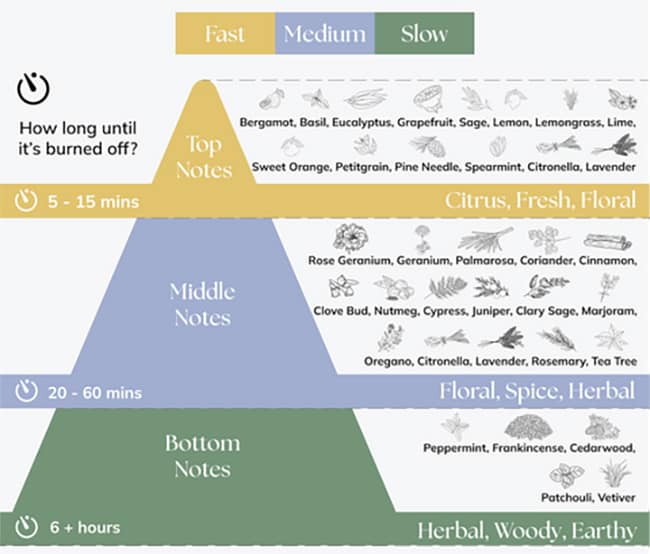Essential oil notes are used to determine the strength and fragrance of each individual oil.
Although each essential oil is sold ready-made to use individually, there are many ways you can blend them to create your own unique scent, whether in a candle, soap or for a massage oil.
What is the best way to categorize essential oils?

There are three main ways to categorize essential oils:
- Fragrance notes: Essential oils can be divided into three different scent notes: top, middle and bottom.
- Fragrance type: Fragrance examples of an essential oil include herbal, citrus, floral and woody.
- Effect: This describes the effect an essential oil can create, such as relieving anxiety or providing a pick-me-up.
Fragrance notes from essential oils
What is a top note of an essential oil?
A top note essential oil describes the very first scent you smell when you inhale the oil. In most cases, they are light and fresh, bringing your senses to life before the note quickly dissipates. Compared to the middle and base notes, they do not linger as long, with the bottom notes tending to linger and be more dominant.
Most citrus oils are top notes (such as lemon and grapefruit), but eucalyptus and bergamot also fall into this category. When the right top note is used in an essential oil, it can instantly leave an impression that encourages you to explore the full depth of the scent so that you can enjoy the aroma no matter how you apply it.
What is a heart note of an essential oil?
Below the top note, you soon begin to smell the heart note of the oil, which serves as the main note of the blend. Because of the higher concentration, heart notes linger longer than top notes and are usually floral or spicy scents such as lavender or rosemary.
If you are mixing multiple essential oils for a recipe (whether for a soap, candle or cleansing spray), the middle note or heart note is the most important one to choose. Look at the various health benefits it can offer and how it will blend with higher and lower notes to create a fully rounded scent. Also remember that heart notes are often used to relieve anxiety and stress, and in some cases linger for up to 2 hours.
What is an essential oil with a base note?
At the base of a blend of essential oils is the base note, which lingers the longest. This is because they contain heavier molecules, so your senses are aware of the note long after the middle and top notes have evaporated. It is similar to when you spray a perfume or aftershave on your hand, because the scent will change on your skin, leaving the base note behind after the higher notes have evaporated.
Popular bass notes used in blends are ylang ylang, frankincense and jasmine, while clary sage and peppermint are also commonly used. Since this will be the longest-lasting note in your blend, do some research on what other types of light oils will complement it.
Overview essential oil notes
To get you started with your first blend, check out our essential oil notes table, which categorizes your favorite oils so you can blend them into an exciting new blend.
Blending essential oils by note
You can use the above information as a starting point for mixing essential oils by note.

As we mentioned, oils evaporate at different rates, so by creating a blend made up of different notes, you can enjoy a scent that changes in a similar way to how perfumes and aftershaves evolve once sprayed on the skin.
When it comes to mixing essential oils by note, it is a good idea to follow the 30/50/20 rule. This makes it easier to find the right balance of oils used in your blend, where 30% is top note, 50% middle note and 20% base note.
For example, if you use a total of 10 drops in your blend, this would mean that you use 3 drops of top note, 5 of middle note and 2 of base note.
Of course, some blends use more than three oils, so you can apply the same ratio with a different combination of oils. For example, this could be 20% of a top note with 10% of another top note, combined with 50% middle note and 20% base note. You can also use 30% top, 20% of a middle note with 30% of another middle note, ending with 20% base.
Illustration of a leaf branch
Making your own blend of essential oil notes does not have to be complicated, especially if you know where each note is on the scale.
Once you’ve made your mixture, we recommend storing it in an amber glass bottle in a cool, dry place away from heat and light – you should also wait at least 48 hours before using it for the first time.
It is a concentrated blend that you can use in soaps, candles, waxmelts, diffusers, lotions, etc. If you want to make perfume, you mix your blend with our perfume base.
